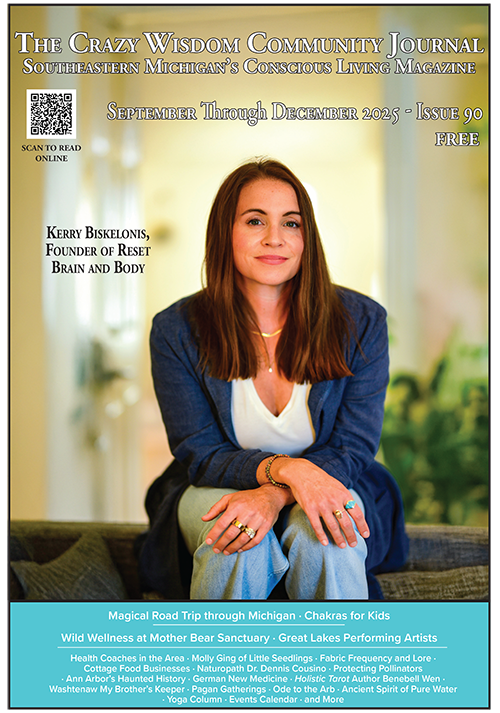Our Southeast Michigan watersheds are the Huron River, Rouge River, Clinton River, River Raisin, and Ecorse Creek Watersheds. All of these nets of nomadic water empty into the Detroit River (which has its own watershed). Detroit River waters flow into Lake Erie, then travel through the Niagara River merging into Lake Ontario, narrowing again into the St. Lawrence River, and releasing finally into the Atlantic Ocean.
Green Living: The Sustainability Imperative: A Call to Slow Down and the Cost of Convenience in Shopping Small
In a world that often feels like it’s spiraling out of control—where climate crises loom, cities buzz relentlessly, and our pace of life rarely allows for a breath—it’s easy to feel overwhelmed. Amid this chaos, movements like sustainability, slow living, and shopping small have emerged as radical yet simple antidotes. What ties these practices together is the pursuit of a more intentional, connected, and grounded life. Each contributes not only to personal well-being but also to the health of our communities and planet. This interconnected wisdom offers us a pathway to stay sane in an increasingly unstable world.
Handcrafting~ Autumn Wild Crafting
Autumn is the season of bounty, and it’s so easy to end up coming home after a wander into the natural spaces around us with pocket loads of natural treasures. Why not engage in some creative crafting with your harvest? Here are a few of my favorite autumn wild crafts to make the most of your gathering.
Green Living~Foraging and Using Natural Materials for Home Crafting
Nature provides a variety of inspiring materials that can be useful for crafting traditional and useful things. What a joy it is to learn, year by year, a bit more about the qualities of the natural world by foraging and co-creating with nature.
Green Living: More Life, Less Stuff
There were seventeen sets of nail clippers. Books were on the shelves, books in boxes under the bed, and even more books in the attic. I found at least two dozen pairs of eyeglasses each with a sunglass inset. A microscope. Three weed whackers, four typewriters, and the boxes from every appliance he owned. At least 15 winter coats—why so many coats?
Green Burial: From Stardust to Soil
On a cloudy afternoon this past winter, as we stood in the muted, gray light of our kitchen, I said to my wife, “When I die, just put me in the ground, maybe wrapped in a shroud—or in a pine box, or something like that—and let nature do its thing.”
Urban Ashes: Triple Wins for the Economy, People, and the Environment
Paul Hickman is one of a number of individuals and companies nationwide, who have a better idea—actually a number of better ideas—about ways to put those 600 trees, and the many thousands more every year throughout the US, to better uses and to sequester their carbon. Hickman is founder of Urban Ashes, a local company that, since 2009, has been using salvaged wood to produce furniture and picture frames, and has done it primarily by employing formerly incarcerated people, a frequently marginalized population.
Gateway Farm: Growing with Permaculture
The mid-January day I visited Gateway Farm in Plymouth was breezy, and the temperature was in the low thirties with faint flurries falling. At the farm’s small, dirt parking lot off Joy Road, I met Bridget O’Brien who, along with her husband Dr. Charlie Brennan, is the farm’s co-director. After we greeted each other, I said, “Not the best time of the year for me to see the farm, I guess.” “It’ll be okay,” she replied cheerfully. “We’ll be able to see everything because there’s no snow on the ground. Plus,” she added, “The sorrel is still green.”
Green Living: Ditching the Paper Towel
Did you know the invention of paper towels was completely accidental? Many are familiar with the Scott Paper Company which founded toilet paper all the way back in 1879. In the early 20th century, the Scott plant received a railroad car’s worth of paper rolled too thick for toilet paper. Instead of scrapping the whole load, one of the founders used a story he heard about a school using small pieces of soft paper to hand out to students with runny noses during flu season as an entrepreneurial opportunity. The paper was perforated into small towel-sized sheets, called Sani-Towel, and sold to hotels, restaurants, and railroad stations for use in restrooms. It wouldn’t be until almost 30 years later before paper towels were popularized for household kitchens the way they are today.
Green Living: Bring Your Own Container, Leave with a New Way to Live
It is a song many of us sing every day: the last swipe of lotion on a dry day leaves a container empty; the final drizzle of olive oil escapes the bottle and sizzles on the pan; the old water kettle stops boiling; it is time to throw it all out and start over with something new.
Bringing Nature Back to Our Yard: Trading In Harmful Landscaping Habits for Healthy Sustainability
Late winter is the time we may start dreaming about the color green, about flowers, imagining new vistas as we look out our windows or walk around our frozen yard. This is a wonderful time to explore a fresh outlook on our little piece of earth. As new life emerges from dormancy, we may ask ourselves, “What is the purpose of my yard?” There are many possible answers: enjoying beauty and colorful flowers, complying with homeowners’ association regulations, conforming to the neighborhood, impressing neighbors and friends, creating a safe space for the kids to play, or wanting to help save our planet.
Green Living: Putting Our Yards to Bed For Winter
Over the past six months, we’ve witnessed the transformation from last winter’s dormancy into a lush and verdant summer. We’ve been enjoying the fruits of Nature’s labors—beauty, food, and shade from flowers, vegetables, and trees. Now is the time in our cycle when all this foliar production returns to earth. What has increased must decrease. For leafy life to begin anew next spring, all this green must become brown and nourish the soil.
Green Living: Tips For Keeping Our Indoor (and Outdoor!) Air Clean
We are in our homes, and our yards (yay Spring!), more than ever. What can we do in and around our homes to be healthier and care for our environment more? There’s a lot of easy things that can make a big difference. Let’s start with our indoor air.
How Your Grandmother Paved the Way for Green Living
My grandmothers were many things. Wise, kind, the best at giving hugs, and the best at baking cookies, as I’m sure your own grandmothers were. When I look around at things as they are today, I often wonder what my maternal grandmother, who lived her life as a farm wife, would have thought of the fast pace of our current world. I don’t have to wonder what she could have taught me about the ongoing efforts I make to live more sustainably, though. I learned those tips from watching both of my grandmothers throughout my life
Green Living: More Than the Three R’s: Refuse, Reduce, Reuse, Recycle… Rot
When thinking about ways to be more sustainable, recycling is often the first option that comes to mind. Sustainability is often presented to us in the neat and tidy rule of three: Reduce, Reuse, Recycle. However, recycling should actually be viewed more as a last-ditch effort since most materials can only be recycled a few times before hitting the landfill. Instead, the focus needs to be centered around the Five R’s: Refuse unsustainable products, Reduce the amount of resources you consume, Reuse or repurpose what you can, and Recycle anything possible before jumping directly to your trash can as the easiest method of disposal.
The Devil Wears Denim, or Linen, or Wool — Locally Sourced Clothing is Good for People and the Planet
“Buy local.” It’s a phrase we’ve seen for years, encouraging us to support the mom and pop down the street, the independent bookstore, and the small retailer. Local food and the local food economy have grown in Michigan over the last decade, and the Ann Arbor Farmers Market features new farmers every year, but there are other needs and areas that could benefit from using the same lens. Clothing is one of them.
One Step Toward Zero Waste
There was genuine shock on my face when my youngest sister, at just 11-years-old, accompanied me to a Starbucks on a weekend visit and very firmly told the barista that no, thank you, she did not need a straw. She had brought her own. My shock continued as she reached into her purse and pulled out a reusable metal straw. After she finished her drink, she then lovingly washed it out and put it away before we continued with our day. I’d like to say I taught her that, but unfortunately this is one I can’t take credit for. She informed me it was a trend among children her age right now, all of them buying reusable straws with the rallying cry of “save the turtles.”
The Ecology Center – 50 Years of Innovative Solutions for Healthy People and a Healthy Planet
n 2020, the Ecology Center of Ann Arbor will be celebrating its 50th anniversary. It has grown to become one of the most dynamic and influential organizations of its kind in the United States. Created in the wake of the first Earth Day, the Ecology Center was founded by members of ENACT (Environmental Action for Survival), the University of Michigan’s student environmental group. ENACT and the Ecology Center’s primary original focus was to start a recycling program. The city’s first recycling program, at the newly created Recycling Center, was not the recycling program Ann Arbor residents know today: no curbside pickup, only a few types of recyclables were eligible, and residents had to sort recyclables into separate containers and deliver them directly to the Recycling Center.
True Colors: Growing and Creating Local Color with Colorwheel
Color matters. Nature uses color to attract a mate, warn of danger, lure food, and to signal hormone changes. Skin is limited in its color, so our clothing does most of the signaling for us. Mood, emotion, personality, confidence—all of this is cued through color. What colors to wear to an interview? What colors to wear on a first date? What colors to wear to an evening professional event? Neutrals with a touch of color connote professionalism and reliability, but wearing bright color is more eye-catching when out in the evening. Cultural context can change the meaning of color, but it doesn’t change the pattern of using color to communicate.
Celebrating the Ecology Center's 50 year Anniversary--More interviews!
In addition to the interview with Garfield (see the main article here), freelance journalist Sandor Slomovits contacted a few other people who have been associated with the Ecology Center in the past fifty years and asked them to discuss the history and accomplishments of the organization. To provide a multifaceted picture of the EC, he got in touch with people who worked at the EC during various points in its history, and who held different positions and served in a variety of capacities, from staff and leadership, to volunteers.






























































































































































































